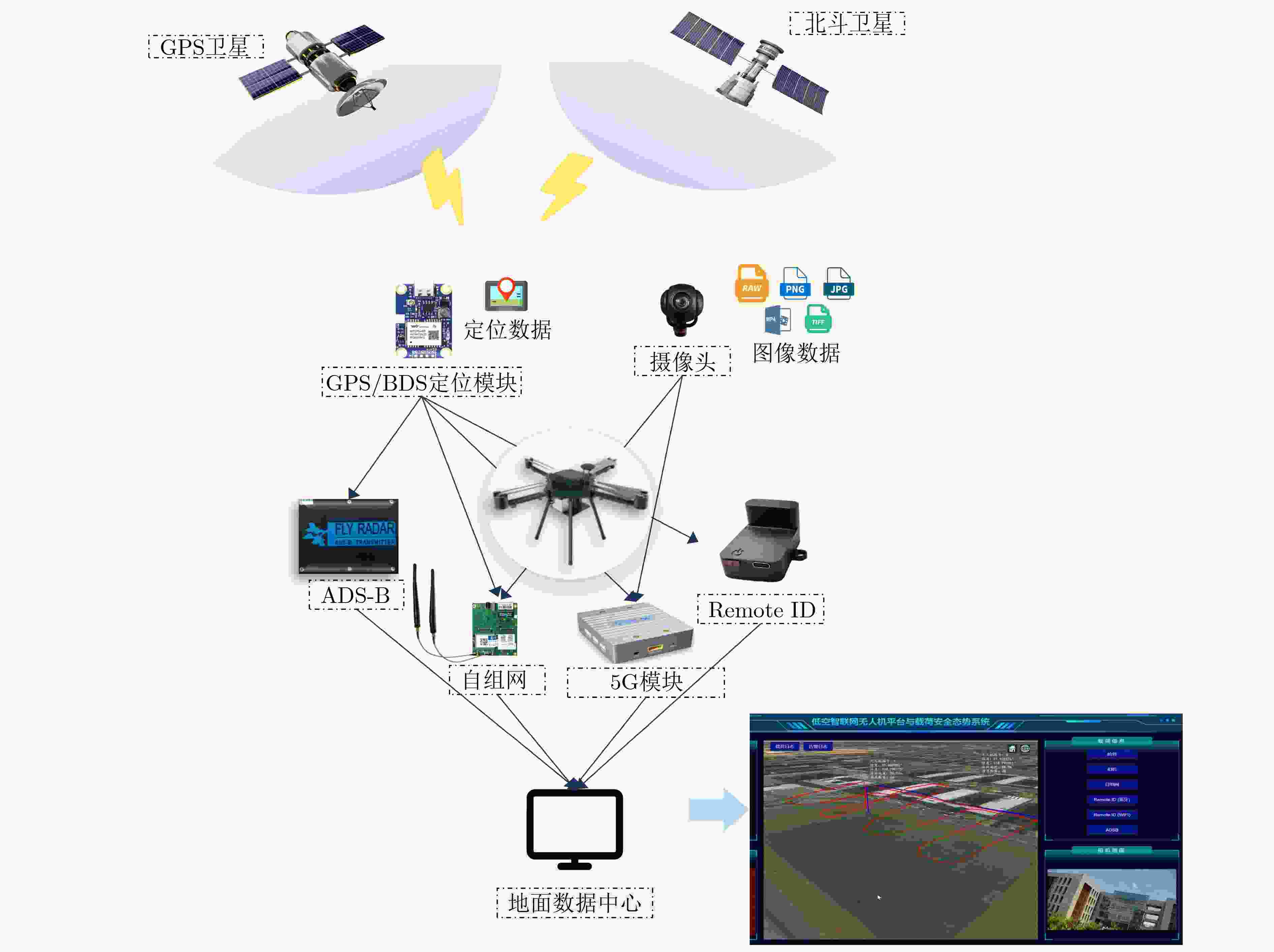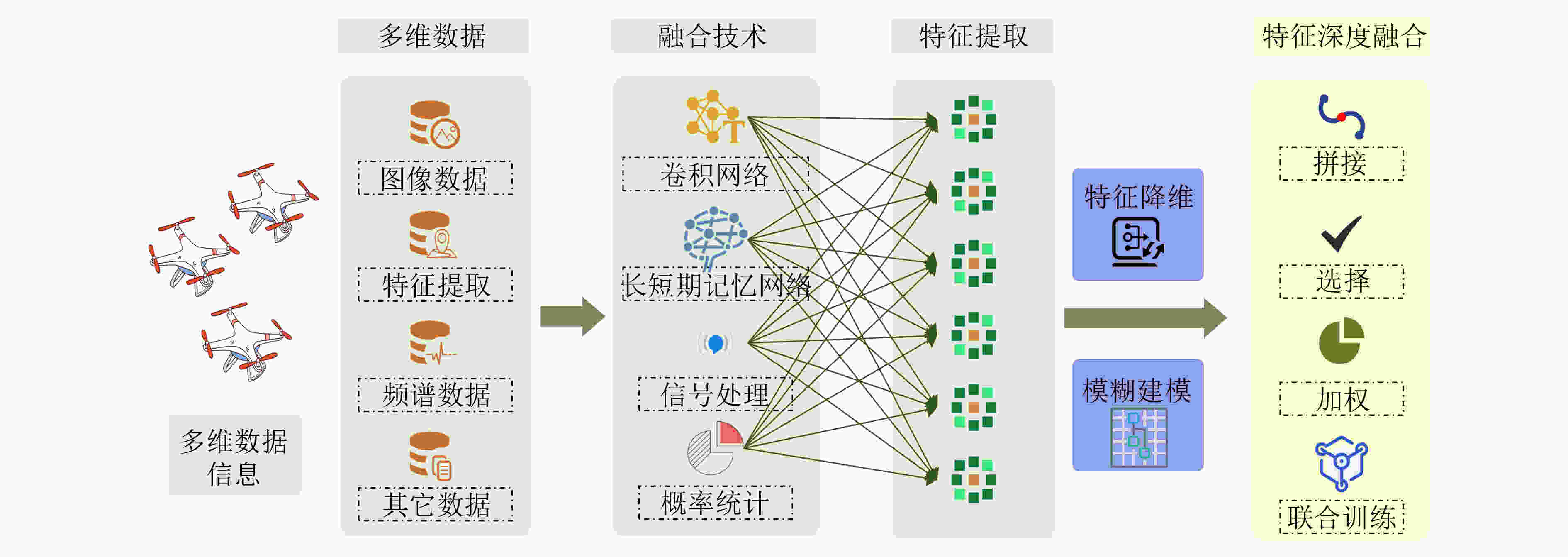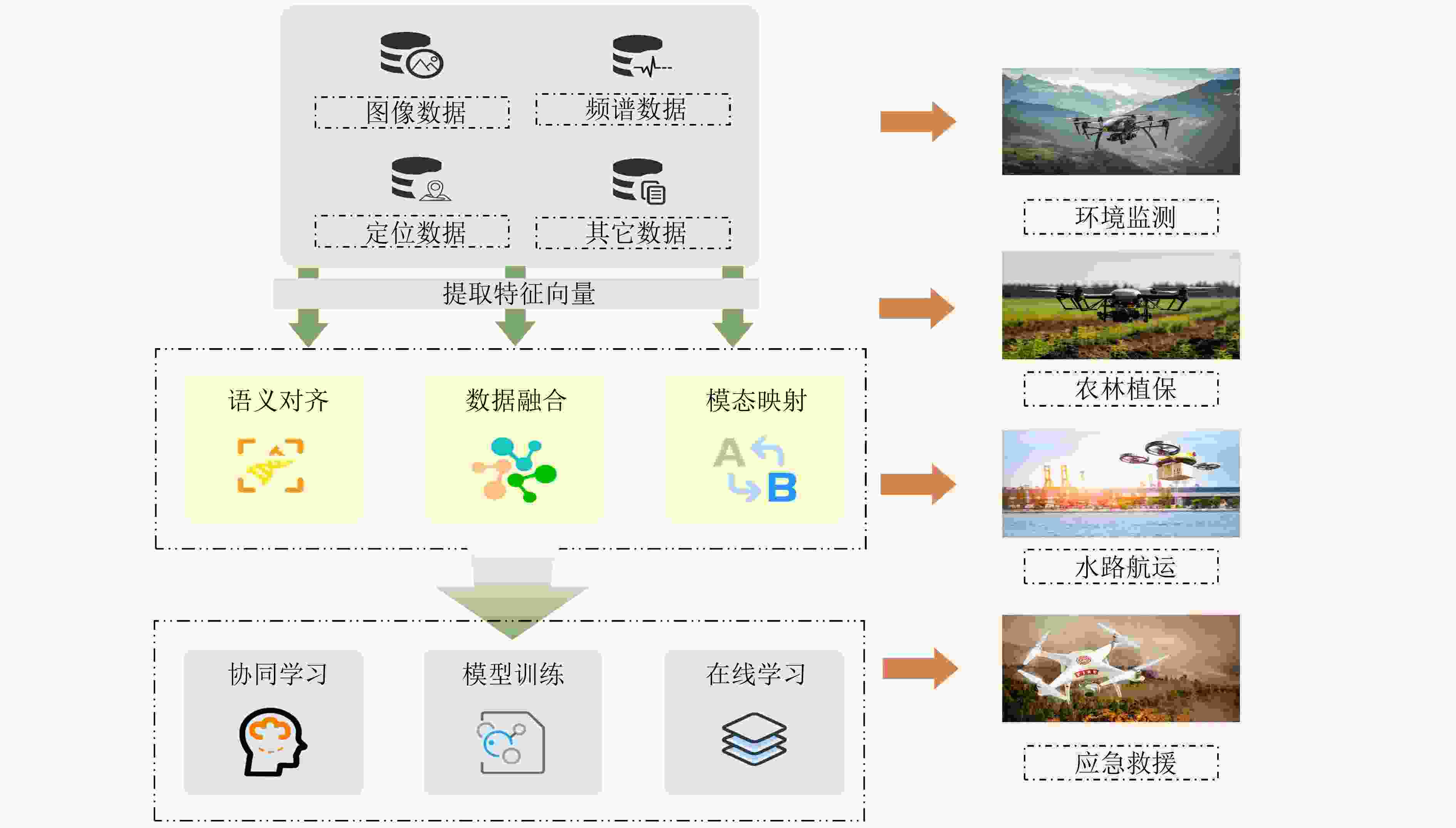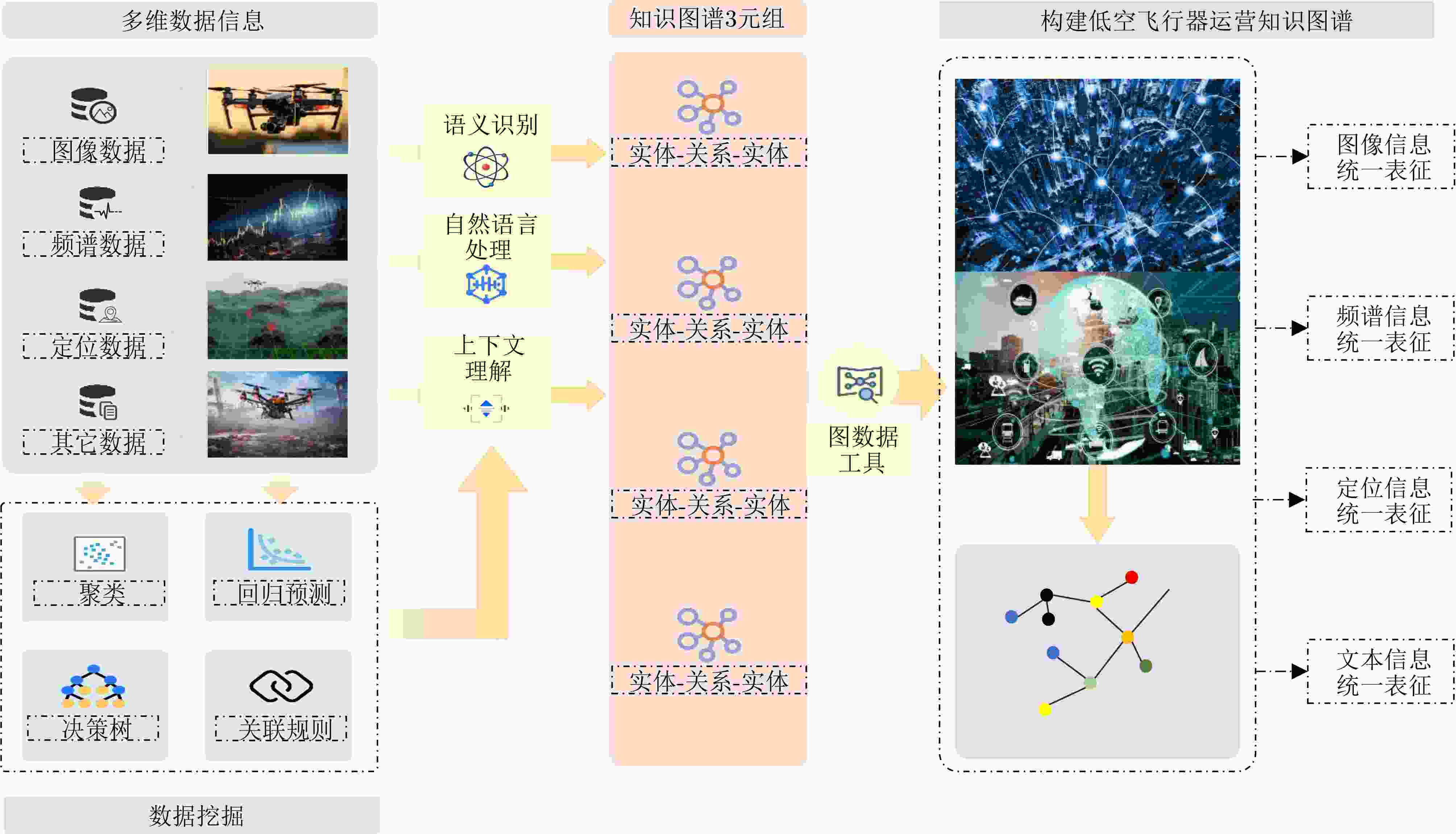Survey of Unified Representation Technology of Multi-dimensional Information for Low Altitude Intelligent Network
-
摘要: 作为新质生产力的低空智联网(LAIN),通过构建多种应用场景下的3维网络体系,可协助实现泛在覆盖和万物互联的美好愿景。然而,随着LAIN的快速发展,在数据采集和利用过程中,分布式飞行器和地面设备在运营过程中所产生的数据来源广泛、格式各异,但由于尚未形成对数据的统一表征标准,极大地限制了LAIN中信息共享和有效利用。因此,该文首先总结了当前国内外相关研究现状,分析了LAIN下潜在的异构数据类型,指明其主要特征和应用场景;然后,设计了LAIN数据集成与融合的示范平台;其次,剖析了实现LAIN下多维异构信息统一表征所面临的挑战;进而,基于数据融合技术、时空栅格化技术、多模态协同推理以及知识图谱,提出潜在的融合与集成表征方法,构建统一的知识表征模型框架,以期实现不同信息源数据的语义对齐和集成;最后,对所述内容进行总结,并展望了未来的研究方向,旨在为LAIN的进一步发展提供理论基础和技术支持,推动LAIN信息资源的高效利用和智能化发展。Abstract:
Significance The Low Altitude Intelligent Network (LAIN) has emerged as a critical productive force in recent years, particularly with the growing strategic role of the low-altitude economy in national development plans. As an integral part of smart city infrastructure and advanced air mobility systems, LAIN contributes both to economic growth and to airspace security. By integrating unmanned aerial vehicles, fifth-generation communication technologies, and artificial intelligence, LAIN enables real-time monitoring and provides services for urban traffic, agriculture, and disaster management. This integration optimizes resource allocation and enhances public safety. However, the rapid development of LAIN results in a vast array of distributed aircraft and ground equipment that generate large volumes of heterogeneous data in various formats. The absence of a unified representation standard significantly hinders the efficient utilization of data within the LAIN ecosystem, presenting substantial challenges for its widespread application in complex real-world scenarios. Therefore, the development of a unified data representation model for multi-dimensional and heterogeneous information within LAIN is essential to eliminate data heterogeneity, enhance data utilization efficiency, and promote the deep integration of the low-altitude economy with the digital economy. Process Existing research has explored innovative methods and technologies for information representation and addressing potential challenges in the LAIN. However, current solutions remain domain-specific and lack adaptability to the dynamic environment of LAIN. The absence of targeted research and standards makes it difficult to establish a unified representation for multi-source data. To bridge this gap, a heterogeneous information unified representation model is proposed for LAIN. This paper aims to address the challenges posed by complex data and information in the LAIN environment, particularly within the context of the sixth generation of communication technologies, and to provide new approaches for data management and application in LAIN. First, the heterogeneous data types within LAIN are categorized, highlighting their key characteristics and application scenarios. A platform for LAIN data integration and fusion is then developed, incorporating multiple technologies to facilitate efficient data collection, transmission, processing, and visual display. Additionally, the challenges of achieving a unified representation of multi-dimensional and heterogeneous information within LAIN are analyzed. Finally, promising methods for data fusion and representation are discussed, including data fusion, spatiotemporal gridding data technology, multi-mode technology, and knowledge graphs. These methods aim to establish a unified knowledge representation model and achieve semantic alignment, enabling the integration of data from diverse sources. Specifically, multi-source data are preprocessed to enhance understandability and availability through multi-level fusion, integrating multi-dimensional information from various sensors and data sources within a unified framework. Spatiotemporal gridding standardizes data formats and captures spatiotemporal changes, thereby effectively processing and integrating multi-source, multi-dimensional spatial data. Furthermore, integrating multi-mode data through multi-mode technology is expected to improve decision-making accuracy, while the knowledge graph links multi-source data, constructing a knowledge network that standardizes and correlates information from various sources, formats, and semantics. Prospects With the advancement of multi-dimensional data unified representation technology, the LAIN is poised to integrate with edge computing, radio knowledge description languages, large language models, and other emerging technologies to enable intelligent analysis and autonomous decision-making for low-altitude systems. Specifically, data processing can be optimized through edge computing. By positioning edge devices closer to the terminal, edge computing facilitates preprocessing and preliminary analysis at the data source. This technology enhances response speed and efficiency, providing high-quality services for the rapid acquisition and unified representation of LAIN information. Data from various sensors and systems can be structured and represented in an organized manner, facilitating data exchange between different systems, enabling readable spectrum management policies, and reducing interference incidents. Additionally, large language models can assist in constructing and refining knowledge graphs, advancing the intelligent operation and management of low-altitude aircraft. These promising technologies are expected to support further fusion and unified representation of LAIN data, laying a foundation for future research in the LAIN field. Conclusions This paper systematically addresses the challenges of multi-dimensional data representation in the LAIN through a combination of theoretical innovation and technological integration. The main contributions of this paper include: (1) A summary of related works in the field, with an introduction to potential heterogeneous data types, their key characteristics, and relevant application scenarios. (2) The proposal of a low-altitude information fusion and monitoring system, with an analysis of the challenges in achieving unified data representation. (3) The introduction of key technologies such as data fusion, spatiotemporal gridding data technology, multi-mode technology, and knowledge graphs. Additionally, edge computing technology, radio knowledge description language, and large language model technology are integrated to enhance data fusion and unified representation in LAIN. The findings of this study provide both theoretical and technical support for the development of LAIN, fostering the efficient utilization and intelligent advancement of information resources. -
表 1 低空智联网多维数据融合方法
融合方法 主要特点 优缺点 应用场景 数据级融合 整合原始数据,保留完整信息,存储、处理开销高 信息完整性高,同时对数据质量要求高 数据量大且多源数据具有高度互补性,需要直接整合原始数据的场景 特征级融合 整合数据主要特征,可提高数据表示和分析效果,实时性强 鲁棒性更强,能综合多源数据特征,但特征提取算法依赖度高,可能导致信息损失 智能交通、农业监测、公共安全等需要从多源数据中提取和综合多源数据
特征的场景决策级融合 不同数据源的数据或特征进行分析和决策后,整合独立决策结果,可有效提高决策准确性和可靠性,灵活性高,鲁棒性强,抗干扰能力强 灵活性高,鲁棒性强,但融合算法
相对复杂UAV导航、目标识别、灾害预警等需进行独立决策以提高决策准确性和
可靠性的场景 -
[1] 吴启晖, 董超, 贾子晔, 等. 低空智联网组网与控制理论方法[J]. 航空学报, 2024, 45(3): 028809. doi: 10.7527/S1000-6893.2023.28809.WU Qihui, DONG Chao, JIA Ziye, et al. Networking and control mechanism for low-altitude intelligent networks[J]. Acta Aeronautica et Astronautica Sinica, 2024, 45(3): 028809. doi: 10.7527/S1000-6893.2023.28809. [2] 张洪海, 邹依原, 张启钱, 等. 未来城市空中交通管理研究综述[J]. 航空学报, 2021, 42(7): 024638. doi: 10.7527/S1000-6893.2020.24638.ZHANG Honghai, ZOU Yiyuan, ZHANG Qiqian, et al. Future urban air mobility management: Review[J]. Acta Aeronautica et Astronautica Sinica, 2021, 42(7): 024639. doi: 10.7527/S1000-6893.2020.24638. [3] 廖小罕, 徐晨晨, 叶虎平. 低空经济发展与低空路网基础设施建设的效益和挑战[J]. 中国科学院院刊, 2024, 39(11): 1966–1981. doi: 10.16418/j.issn.1000-3045.20240614002.LIAO Xiaohan, XU Chenchen, YE Huping. Benefits and challenges of constructing low-altitude air route network infrastructure for developing low-altitude economy[J]. Bulletin of Chinese Academy of Sciences, 2024, 39(11): 1966–1981. doi: 10.16418/j.issn.1000-3045.20240614002. [4] NEW W K and LEOW C Y. Unmanned Aerial Vehicle (UAV) in future communication system[C]. The 2021 26th IEEE Asia-Pacific Conference on Communications (APCC), Kuala Lumpur, Malaysia, 2021: 217–222. doi: 10.1109/APCC49754.2021.9609875. [5] 樊邦奎, 李云, 张瑞雨. 浅析低空智联网与无人机产业应用[J]. 地理科学进展, 2021, 40(9): 1441–1450. doi: 10.18306/dlkxjz.2021.09.001.FAN Bangkui, LI Yun, and ZHANG Ruiyu. Initial analysis of low-altitude internet of intelligences (IOI) and the applications of unmanned aerial vehicle industry[J]. Progress in Geography, 2021, 40(9): 1441–1450. doi: 10.18306/dlkxjz.2021.09.001. [6] RAY P P. A review on 6G for space-air-ground integrated network: Key enablers, open challenges, and future direction[J]. Journal of King Saud University-Computer and Information Sciences, 2022, 34(9): 6949–6976. doi: 10.1016/j.jksuci.2021.08.014. [7] 史殿习, 洪臣, 康颖, 等. 面向多无人机协同飞行控制的云系统架构[J]. 计算机学报, 2020, 43(12): 2352–2371. doi: 10.11897/SP.J.1016.2020.02352.SHI Dianxi, HONG Chen, KANG Ying, et al. Cloud-based control system architecture for multi-UAVs Cooperative flight[J]. Chinese Journal of Computers, 2020, 43(12): 2352–2371. doi: 10.11897/SP.J.1016.2020.02352. [8] 刘畅行, 陈思衡, 杨峰. 基于多模态大模型的智能无人机系统: 总结与展望[J]. 无线电工程, 2024, 54(12): 2923–2932. doi: 10.3969/j.issn.1003-3106.2024.12.020.LIU Changxing, CHEN Siheng, and YANG Feng. Review of intelligent UAV systems based on large multimodal models[J]. Radio Engineering, 2024, 54(12): 2923–2932. doi: 10.3969/j.issn.1003-3106.2024.12.020. [9] 卢锟, 李荣鹏, 赵志峰, 等. 基于统一语义表征的多用户异构语义网络[J]. 移动通信, 2023, 47(4): 37–44. doi: 10.3969/j.issn.1006-1010.20230305-0001.LU Kun, LI Rongpeng, ZHAO Zhifeng, et al. Multi-user heterogeneous semantic network based on unified semantic representation[J]. Mobile Communications, 2023, 47(4): 37–44. doi: 10.3969/j.issn.1006-1010.20230305-0001. [10] 刘华峰, 陈静静, 李亮, 等. 跨模态表征与生成技术[J]. 中国图象图形学报, 2023, 28(6): 1608–1629. doi: 10.11834/jig.230035.LIU Huafeng, CHEN Jingjing, LI Liang, et al. Cross-modal representation learning and generation[J]. Journal of Image and Graphics, 2023, 28(6): 1608–1629. doi: 10.11834/jig.230035. [11] 李巧玲. 复杂场景下数字孪生多源数据融合技术研究[D]. [硕士/博士论文], 西安工业大学, 2024. doi: 10.27391/d.cnki.gxagu.2024.000467.LI Qiaoling. Research on multisource data fusion technology for digital twins in complex environments[D]. [Master/Ph. D. dissertation], Xi’an Technological University, 2024. doi: 10.27391/d.cnki.gxagu.2024.000467. [12] DU Hao, WANG Wei, XU Chaowen, et al. Real-time onboard 3D state estimation of an unmanned aerial vehicle in multi-environments using multi-sensor data fusion[J]. Sensors, 2020, 20(3): 919. doi: 10.3390/s20030919. [13] XI Lihu, HOU Jingwei, MA Guanglin, et al. A multiscale information fusion network based on PixelShuffle integrated with YOLO for aerial remote sensing object detection[J]. IEEE Geoscience and Remote Sensing Letters, 2024, 21: 7501505. doi: 10.1109/LGRS.2024.3353304. [14] ALLISON J A, PTUCHA R, and LYSHEVSKI S E. Resilient communication, object classification and data fusion in unmanned aerial systems[C]. 2018 International Conference on Unmanned Aircraft Systems (ICUAS), Dallas, USA, 2018: 779–787. doi: 10.1109/ICUAS.2018.8453309. [15] WENG Qian, CHEN Hao, CHEN Hongli, et al. A multisensor data fusion model for semantic segmentation in aerial images[J]. IEEE Geoscience and Remote Sensing Letters, 2022, 19: 6511905. doi: 10.1109/LGRS.2022.3183613. [16] 沈锋, 丁国如, 李婕, 等. 电磁频谱多维态势压缩测绘技术研究进展[J]. 通信学报, 2023, 44(11): 25–42. doi: 10.11959/j.issn.1000-436x.2023174.SHEN Feng, DING Guoru, LI Jie, et al. Research progress on electromagnetic spectrum multidimensional situation compressed mapping technology[J]. Journal on Communications, 2023, 44(11): 25–42. doi: 10.11959/j.issn.1000-436x.2023174. [17] 董超, 经宇骞, 屈毓锛, 等. 面向低空智联网频谱认知与决策的云边端融合体系架构[J]. 通信学报, 2023, 44(11): 1–12. doi: 10.11959/j.issn.1000-436x.2023228.DONG Chao, JING Yuqian, QU Yuben, et al. Cloud-edge-device fusion architecture oriented to spectrum cognition and decision in low altitude intelligence network[J]. Journal on Communications, 2023, 44(11): 1–12. doi: 10.11959/j.issn.1000-436x.2023228. [18] SHANG Bodong, MAROJEVIC V, YI Yang, et al. Spectrum sharing for UAV communications: Spatial spectrum sensing and open issues[J]. IEEE Vehicular Technology Magazine, 2020, 15(2): 104–112. doi: 10.1109/MVT.2020.2980020. [19] SENKUS B, YAMAN B, AYDIN H, et al. Implementation of high performance multi-agent position feeding framework[C]. 2022 24th International Microwave and Radar Conference (MIKON), Gdansk, Poland, 2022: 1–5. doi: 10.23919/MIKON54314.2022.9924764. [20] 杨鑫春, 李征航, 吴云. 北斗卫星导航系统的星座及XPL性能分析[J]. 测绘学报, 2011, 40(S1): 68–72.YANG Xinchun, LI Zhenghang, and WU Yun. The performance analysis of constellation and XPL for compass[J]. Acta Geodaetica et Cartographica Sinica, 2011, 40(S1): 68–72. [21] SAIFIZI M, MUSTAFA W A, RADZI N S M, et al. UAV based image acquisition data for 3D model application[J]. IOP Conference Series: Materials Science and Engineering, 2020, 917(1): 012074. doi: 10.1088/1757-899X/917/1/012074. [22] 罗旭东, 吴一全, 陈金林. 无人机航拍影像目标检测与语义分割的深度学习方法研究进展[J]. 航空学报, 2024, 45(6): 028822. doi: 10.7527/S1000-6893.2023.28822.LUO Xudong, WU Yiquan, and CHEN Jinlin. Research progress on deep learning methods for object detection and semantic segmentation in UAV aerial images[J]. Acta Aeronautica et Astronautica Sinica, 2024, 45(6): 028822. doi: 10.7527/S1000-6893.2023.28822. [23] 韩子硕, 范喜全, 付强, 等. 面向无人机视角的多源信息融合目标检测[J]. 系统工程与电子技术, 2025, 47(1): 52–61. doi: 10.12305/j.issn.1001-506X.2025.01.06.HAN Zishuo, FAN Xiquan, FU Qiang, et al. Target detection based on multi-source information fusion from the perspective of drones[J]. Systems Engineering and Electronics, 2025, 47(1): 52–61. doi: 10.12305/j.issn.1001-506X.2025.01.06. [24] LIAO Yiyang, JIA Ziye, DONG Chao, et al. Interference analysis for coexistence of UAVs and civil aircrafts based on automatic dependent surveillance-broadcast[J]. IEEE Transactions on Vehicular Technology, 2024, 73(10): 15911–15915. doi: 10.1109/TVT.2024.3414502. [25] LIAO Yiyang, ZHANG Lei, JIA Ziye, et al. Impact of UAVs equipped with ADS-B on the civil aviation monitoring system[C]. 2023 IEEE/CIC International Conference on Communications in China (ICCC), Dalian, China, 2023: 1–6. doi: 10.1109/ICCC57788.2023.10233390. [26] ZHANG Yifan, JIA Ziye, DONG Chao, et al. Recurrent LSTM-based UAV trajectory prediction with ADS-B information[C]. GLOBECOM 2022-2022 IEEE Global Communications Conference, Rio de Janeiro, Brazil, 2022: 1–6. doi: 10.1109/GLOBECOM48099.2022.10000919. [27] DONG Chao, ZHANG Yifan, JIA Ziye, et al. Three-dimension collision-free trajectory planning of UAVs based on ADS-B information in low-altitude urban airspace[J]. Chinese Journal of Aeronautics, 2025, 38(2): 103170. doi: 10.1016/j.cja.2024.08.001. [28] RUSENO N, LIN Chungyan, and CHANG S C. UAS traffic management communications: The legacy of ADS-B, new establishment of remote ID, or leverage of ADS-B-like systems?[J]. Drones, 2022, 6(3): 57. doi: 10.3390/drones6030057. [29] KHAN, S, GABA G S, BOEIRA F, et al. Formal verification and security assessment of the drone remote identification protocol[C]. 2024 2nd International Conference on Unmanned Vehicle Systems-Oman (UVS), Muscat, Oman, 2024: 1–8. doi: 10.1109/UVS59630.2024.10467159. [30] MURRELL E, WALKER Z, KING E, et al. Remote ID and vehicle-to-vehicle communications for unmanned aircraft system traffic management[C]. The 15th International Workshop on Communication Technologies for Vehicles, Bordeaux, France, 2020: 194–202. doi: 10.1007/978-3-030-66030-7_17. [31] ZHANG Lili, XIE Yuxiang, XIDAO Luan, et al. Multi-source heterogeneous data fusion[C]. 2018 International Conference on Artificial Intelligence and Big Data (ICAIBD), Chengdu, China, 2018: 47–51. doi: 10.1109/ICAIBD.2018.8396165. [32] 陈唯实, 黄毅峰, 卢贤锋. 多传感器融合的无人机探测技术应用综述[J]. 现代雷达, 2020, 42(6): 15–29. doi: 10.16592/j.cnki.1004-7859.2020.06.003.CHEN Weishi, HUANG Yifeng, and LU Xianfeng. Survey on application of multi-sensor fusion in UAV detection technology[J]. Modern Radar, 2020, 42(6): 15–29. doi: 10.16592/j.cnki.1004-7859.2020.06.003. [33] CHEN Kaiwen and KOUDAS N. Unstructured data fusion for schema and data extraction[J]. Proceedings of the ACM on Management of Data, 2024, 2(3): 181. doi: 10.1145/3654984. [34] CAI Yuxiang. Research on data fusion method of multi-source complex system[J]. Journal of Web Engineering, 2021, 20(5): 1553–1572. doi: 10.13052/jwe1540-9589.20510. [35] ZHU Yian, JIA Ziye, WU Qihui, et al. UAV trajectory tracking via RNN-enhanced IMM-KF with ADS-B data[C]. 2024 IEEE Wireless Communications and Networking Conference (WCNC), Dubai, United Arab Emirates, 2024: 1–6. doi: 10.1109/WCNC57260.2024.10570914. [36] HUANG Fanghui, HE Yixin, DENG Xinyang, et al. A novel discount-weighted average fusion method based on reinforcement learning for conflicting data[J]. IEEE Systems Journal, 2023, 17(3): 4748–4751. doi: 10.1109/JSYST.2022.3228015. [37] LI Xianfeng and XU Sen. Multi-sensor complex network data fusion under the condition of uncertainty of coupling occurrence probability[J]. IEEE Sensors Journal, 2021, 21(22): 24933–24940. doi: 10.1109/JSEN.2021.3061437. [38] WANG Ze. Knowledge graph service system based on data fusion technology[C]. 2023 International Conference on Applied Intelligence and Sustainable Computing (ICAISC), Dharwad, India, 2023: 1–6. doi: 10.1109/ICAISC58445.2023.10200320. [39] 谢华, 苏方正, 尹嘉男, 等. 复杂低空无人机飞行冲突网络建模与精细管理[J]. 航空学报, 2023, 44(18): 328226. doi: 10.7527/S1000-6893.2023.28226.XIE Hua, SU Fangzheng, YIN Jianan, et al. Network modeling and refined management of UAV flight conflicts in complex low altitude airspace[J]. Acta Aeronautica et Astronautica Sinica, 2023, 44(18): 328226. doi: 10.7527/S1000-6893.2023.28226. [40] HONG Danfeng, CHANUSSOT J, and ZHU Xiaoxiang. An overview of multimodal remote sensing data fusion: From image to feature, from shallow to deep[C]. 2021 IEEE International Geoscience and Remote Sensing Symposium IGARSS, Brussels, Belgium, 2021: 1245–1248. doi: 10.1109/IGARSS47720.2021.9554255. [41] CHEN Donghua and ZHANG Runtong. Building multimodal knowledge bases with multimodal computational sequences and generative adversarial networks[J]. IEEE Transactions on Multimedia, 2024, 26: 2027–2040. doi: 10.1109/TMM.2023.3291503. [42] QIANG Ma, TAO Xu, and GANG Daiyu. Research and implementation of archives knowledge base for multi-source heterogeneous data fusion[C]. 2022 4th International Conference on Frontiers Technology of Information and Computer (ICFTIC), Qingdao, China, 2022: 462–465. doi: 10.1109/ICFTIC57696.2022.10075283. [43] ZENKERT J, HOLLAND A, and FATHI M. Discovering contextual knowledge with associated information in dimensional structured knowledge bases[C]. Proceedings of 2016 IEEE International Conference on Systems, Man, and Cybernetics (SMC), Budapest, Hungary, 2016: 001923–001928. doi: 10.1109/SMC.2016.7844520. [44] JI Shaoxiong, PAN Shirui, CAMBRIA Erik, et al. A survey on knowledge graphs: Representation, acquisition, and applications[J]. IEEE Transactions on Neural Networks and Learning Systems, 2022, 33(2): 494–514. doi: 10.1109/TNNLS.2021.3070843. [45] LÓPEZ-CIFUENTES A, ESCUDERO-VIÑOLO M, BESCÓS J, et al. Semantic-aware scene recognition[J]. Pattern Recognition, 2020, 102: 107256. doi: 10.1016/j.patcog.2020.107256. [46] 陈囿任, 李勇, 温明, 等. 多模态知识图谱融合技术研究综述[J]. 计算机工程与应用, 2024, 60(13): 36–50. doi: 10.3778/j.issn.1002-8331.2309-0481.CHEN Youren, LI Yong, WEN Ming, et al. Research and comprehensive review on multi-modal knowledge graph fusion techniques[J]. Computer Engineering and Applications, 2024, 60(13): 36–50. doi: 10.3778/j.issn.1002-8331.2309-0481. [47] XIAO Zhu, CHEN Yanxun, JIANG Hongbo, et al. Resource management in UAV-assisted MEC: State-of-the-art and open challenges[J]. Wireless Networks, 2022, 28(7): 3305–3322. doi: 10.1007/s11276-022-03051-4. [48] LIAN, Yongxing, QIAN Liang, DING Lianghui, et al. Semantic fusion infrastructure for unmanned vehicle system based on cooperative 5G MEC[C]. 2020 IEEE/CIC International Conference on Communications in China (ICCC), Chongqing, China, 2020: 202–207. doi: 10.1109/ICCC49849.2020.9238949. [49] YU Yue, WU Jun, TANG Xiao, et al. Distributed downloading strategy for multi-source data fusion in edge-enabled vehicular network[C]. 2019 IEEE/CIC International Conference on Communications in China (ICCC), Changchun, China, 2019: 1–6. doi: 10.1109/ICCChina.2019.8855944. [50] JING Yi, WANG Jingjing, JIANG Chunxiao, et al. Satellite MEC with federated learning: Architectures, technologies and challenges[J]. IEEE Network, 2022, 36(5): 106–112. doi: 10.1109/MNET.001.2200202. [51] MITOLA J. Cognitive radio[D]. [Ph. D. dissertation], Royal Institute of Technology, 2000. [52] WAN Fanqi, HUANG Xinting, CAI Deng, et al. Knowledge fusion of large language models[C]. The Twelfth International Conference on Learning Representations, Vienna, Austria, 2024. [53] PAN Shirui, LUO Linhao, WANG Yufei, et al. Unifying large language models and knowledge graphs: A roadmap[J]. IEEE Transactions on Knowledge and Data Engineering, 2024, 36(7): 3580–3599. doi: 10.1109/TKDE.2024.3352100. -






 下载:
下载:






 下载:
下载:
